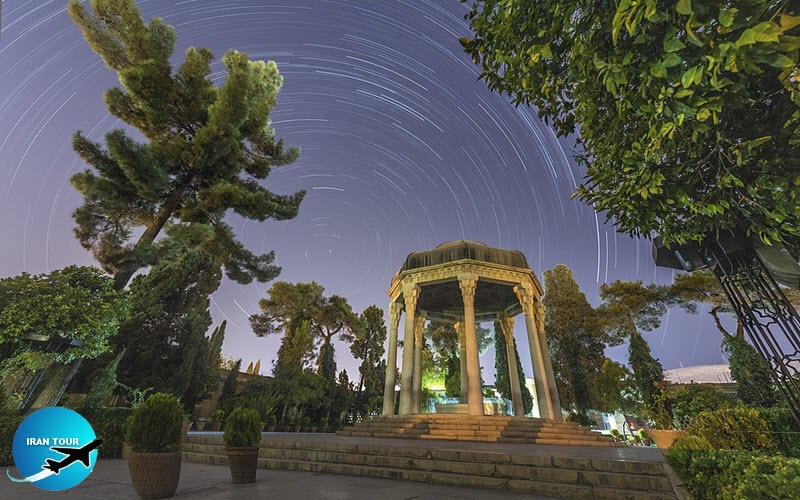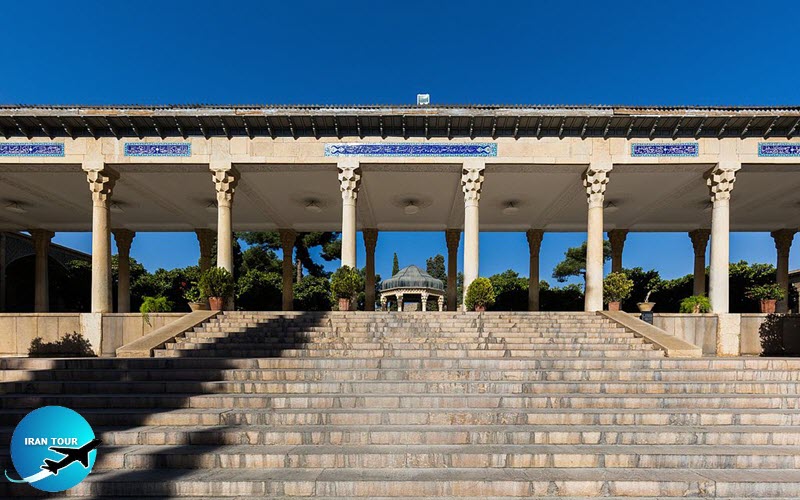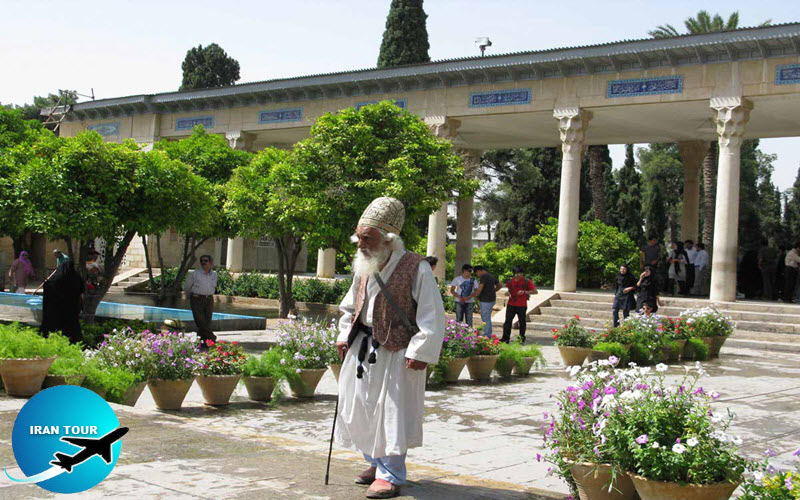Copyright 2020 - 2021 irantour.tours all right reserved
Designed by Behsazanhost
Mausoleum of Hafez
Mausoleum of Hafez
When Hafez died, he was buried in the Mosalla cemetery, which stretches from the north bank of the Dry River and Imamzadeh Ali ibn Hamzeh, to the foothills of Mount Chehel Maqam; most of it has been demolished during city construction projects. It is said that the orthodox refused to have Hafez buried in a Muslim cemetery because of his anti-orthodox, sensual poetry; however, influenced by an oracle taken from his poetry they finally agreed to a proper burial. The story may not be true; then again, it may be, since the custom of asking Hafez's Divan (an anthology of poems) for good advice in every situation is still in use. For about sixty years, the poet's burial place was marked only by a plain tombstone, until in 1477 Shams al-Din Mohammad Yaghmai, the vizier of the ruler Mirza Abulqasem Gurkani, set up a domed crypt and created in front of it a pool watered by the Roknabad qanat. The new, splendid edifice was built in 1173 at the time of Karim Khan Zand. Like the majority of contemporary buildings, It consisted of a hall with four sturdy, monolithic, stone columns.
 |
It was open on the north and south sides and flanked by two smaller rooms on the other two sides. The tomb itself was located in the north section of the grounds, while the south section of the site was occupied by a garden. At Karim Khan's order, there was also made a large, marble gravestone, which has survived to this day. It is engraved by Hajj Aqasi Beik Afshar with two of Hafez's poems in beautiful Nastaliq script. The Mausoleum of Hafez was repeatedly repaired under the Qajar rulers but acquired its present form during the years 19351937. It was designed by André Godard, French architect and the first Director of the Iranian Archaeological Society. Following his plan, the columned hall of the Zand period was extended on either side, thus dividing the entire precinct into two sections, a north, and south. Today the colonnade stretches 56 m long in an east-west direction and is supported by twenty columns. Four of these columns have been preserved from the Zand age, while the other sixteen were added during the renovation.
 |
The north section of the complex measures 60 by 50 m. It is dominated by a white rotunda with eight monolithic columns standing on a slightly elevated octagonal platform. The columns support the roof, which is a canopy covered with copper sheeting, and the ceiling beneath is decorated with a mosaic of enameled tiles, and with selected verses from the poet's works inscribed in elegant Nastaliq. The original tombstone was in the middle of the platform. To the south of the court, there are two stone water reservoirs, while the remaining area is a garden. The east wing of the north section accommodates a greenhouse, service sections, and private crypts. The building on the north side houses a library, a bookshop, and the Hafez Study Center. The northwest corner is occupied by one of the most popular teahouses in Shiraz, with its tables surrounding a rectangular pool. The west side is dedicated to administrative purposes. Here, as well, stands a water cistern that has survived from the Zand period. The west section also houses the Qavam family crypt and several graves of famous Shiraz residents, among them the poet Ahli Shirazi; the historian and writer Forsat al-Dowleh; the foremost of the Zahabi dervishes, Mohammad Hashem alZahabi; and many others.
The south section of the compound measures 150 by 80 m and is filled with charming flowerbeds. The Mausoleum of Hafez is the most visited historical and cultural monument in Shiraz. All-day long, Iranians come to the garden to pay him tribute. Pilgrims briefly rest two fingers on the tombstone and recite the first chapter of the Koran in the memory of this, their favorite poet. They also seek insight into their future by reading a randomly selected sonnet from the poet's poem collection.
Hafez: The Chalice of the King
 |
| A Darvish (sufism man) at Hafez Tomb |
How Iranians Visit Hafez Mausoleum
For Iranians, visiting the tomb of Hafez is like going to a relative's grave. Feelings, of course, are more with respect than with grievance. Some bring rose water to wash the tombstone and put flowers on the grave. Then, they touch the tombstone with a few fingers while praying while reciting a chapter from the Koran to ask for the blessing of his soul. Some proceed to ask Hafez to speak to them through his poems and to tell them about the state of their lives or to give them wise advice through the words of his poems. Then they open their eyes and open the book on any page they open at random and continue to read it with enthusiasm.
The concepts and subjects mentioned in Divan-e-Hafez, his complete works, are so linked to life and extremely attractive that we can easily connect to them as if the poet lived at that time and offers us his wise words of 'a friendly way to enrich our lives. This is why a man loves him and continues to read his poems on a daily basis.
- Details
- Category: Museums of Shiraz







